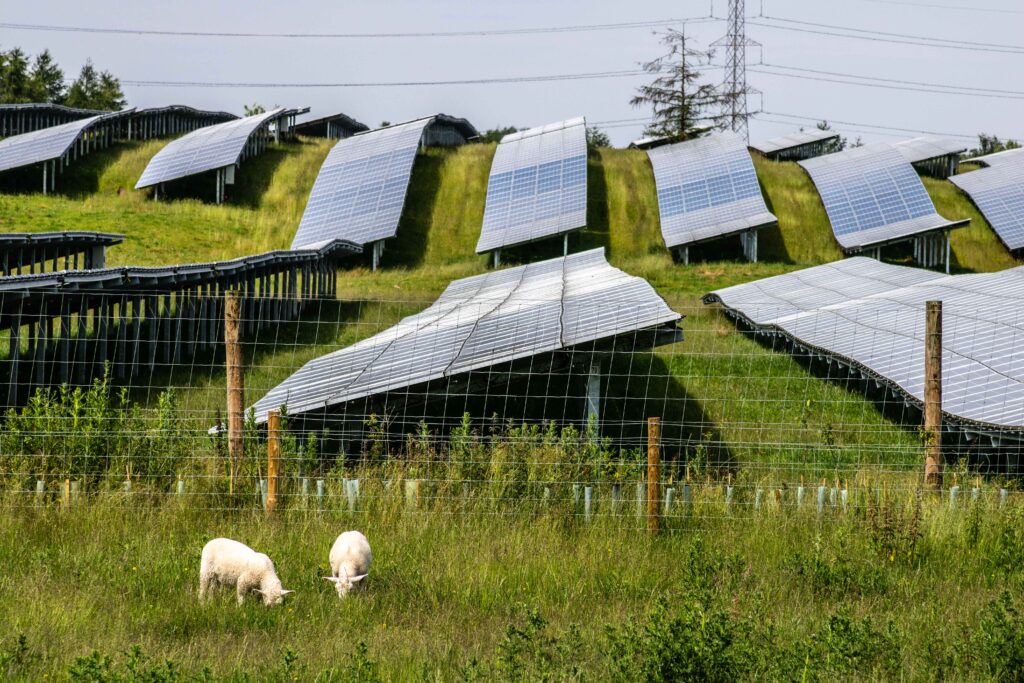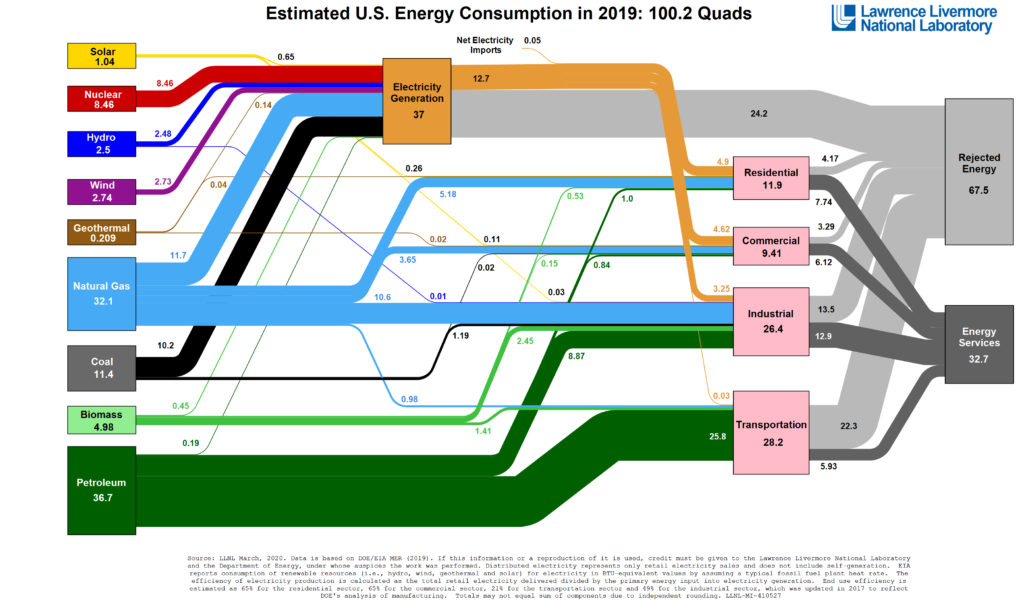
As an American, I’ve often wondered what it would have been like to grow up in a nation that has a year of obligatory service. Usually this is service in a military capacity, but it could be any kind of service. The idea of implementing a mandatory year of public service has gotten some traction in recent years, including a New York Times opinion piece.
What if we applied the concept of a service year to a “wartime footing” on the climate crisis? How quickly could we speed up the pace of deployment of solar power, transmission, and storage infrastructure if we asked every American to spend at least one year being paid to assist the effort?
How many panels would each American need to help install before we could reach 100% clean energy? To find this out let’s begin with per capita energy consumption.
Each year the United States consumes 101 quadrillion BTUs of energy for all uses. Divided by the US population, this means that the average American consumes around 300 million BTUs of energy each year. That’s the energy to support all of the things we do, the energy to grow the food we eat and get it to our tables; it’s the energy embodied in all of the things we buy, in all of the trips we make, in all of the waste we manage, in all the shows we watch.
If we’re going to power the world with solar we’ll need to convert all of that energy to electrical units. 300 million BTUs equals about 88,000 kWh or 88 MWh. But we can’t just assume the same total amount of energy will be used when we switch from a fossil fuel system to a renewable energy system. Sometimes this is referred to as the “primary energy fallacy.”
In fact, by switching to a 100% renewable energy economy where most of our infrastructure is electrified will increase efficiency and reduce the installed capacity requirement. Mark Jacobson, et.al. (Energy Environ. Sci., 2015, 8, 2093) estimate the windfall from electrification efficiency to be such that we would require just 60% of the installed capacity as we would require today in the business-as-usual energy portfolio. In a system where so much of our infrastructure is based on the combustion of heating fuels (coal, fossil gas, etc.), there is a lot of waste. See the light grey “Rejected Energy” box below (67.5 Quads), which is more than twice as large as the dark grey “Energy Services” box (32.7 Quads).

In the zero-carbon economy much our transportation, heating, and industrial energy will come from electricity rather than from combustion. The greater efficiency we will experience from our mostly electric infrastructure means that we can reduce our per capita energy consumption from 88 MWh down to 55 MWh. We can produce that much energy every year using 103 modules (at 400 Watt nameplate capacity each). Our future net-zero carbon energy systems will of course be a mix of hydro, wind, solar, and other technologies, but for sake of argument, if we wanted to power today’s economy using just solar panels, we would each need to do the work of installing 103 of them—along with some amount of energy storage—over our lifetime to contribute equally to the cause.
Multiply by the number of Americans and that comes to around 34 billion modules.
10% of the population (33 million people) are between the ages of 18 and 24. Let’s assume that only 1/3 of the public will be interested in the solar program. There would need to be other options and military service could be one of them. Let’s assume 11 million people participate per year and we’d like to install those 34 billion modules by 2045. That comes to 155 solar modules per person.
Under the Solar Year of Service, each person who participates takes one year to help produce or install 155 solar modules, or assist the effort by teaching, managing, and contributing in some way to the program. This is accomplished through an obligatory one-year service period and would be one of three options available to young people in order to complete their service year.

There are many supply-chain steps along the way to the installation of a solar panel. Any one of these components would be on offer for those choosing their solar year.
- material extraction and processing into polysilicon
- silicon crystal and cell production (or thin-film production)
- power electronics
- assembly
- delivery
- contracts
- siting and permitting
- design
- community engagement
- installation
- commissioning
- operations, maintenance, and monitoring post-installation
Across all of these steps in the process it takes around 12 human labor hours per solar module. That’s 1,860 hours per person for 155 modules, less than the standard 2,000-hour work year in America.
Since each module’s operational life is greater than each human generation, over time the program will serve to implement all of the energy infrastructure required for a flourishing and sustainable society. Commercial, residential, and utility solar installations outside of the program will also continue apace.
Over the course of their year of service, participants in the Solar Year of Service will be engaged in one or two of the supply chain steps in solar module production and installation.
This proposal reinstates an obligatory public service program in the United States (not in effect since the end of the draft—and this time it is for all genders) with a focus on the energy transition, but it offers the option of serving in one of three programs:
- any of the branches of the military,
- the Environmental Stewardship Core (the ESC will be engaged in a federal re-investment in new wealth creation under the terrametic monetary system),
- or the Solar Year of Service program
We have a good understanding of what the administration of the first two options looks like. The Department of Defense and the entire Uniformed Services of the United States will be a critical logistical support component of all three branches of public service. The environmental corps will be housed under the Department of the Interior and will be managed similarly to the way the Civilian Conservation Corps was administered in the 1930s and 40s.
Even if only one third of 18-year-old Americans decided to dedicate their service year to solar, they would together contribute nearly 250 million solar modules (from the processing of raw materials to the installation of the complete system). This is more than 100 times the number of solar modules installed in 2020 and precisely the scale we need to achieve in order to transform our energy system in time to avoid catastrophic global warming.
The service could even be completed over a five-year period on a part-time basis. In this way it can be open to mid-career professionals and to people of all ages. One possible use for this is as a part of a solution to the immigration question. By completing the service requirement anyone can become a citizen of the United States no matter their previous immigration status or documentation. Benefits to existing citizens for voluntarily taking part in the service program could include a lifetime tax credit, a federally backed zero interest home loan, or some other wealth-building mechanism.
The above scenario assumes the program is only focused on solar power technology, but there could also be openings available in wind, wave & tide, river hydro, geothermal, biofuels, storage, and sustainable design.
Many of the participants will go on to careers within the renewable energy industry, which will continue to grow under the incentive structure of terrametrism.
